
* After the lapse of about a decade, in the 1970s, the US military became interested in cruise missiles again. The US Air Force and US Navy went their separate ways on the matter, with the USAF acquiring the "Air-Launched Cruise Missile (ALCM)" and the Navy acquiring the "Submarine-Launched Cruise Missile (SLCM)" -- the SLCM being better known as "Tomahawk". They would both be produced in large quantities. The Navy would also acquire the "Harpoon" antiship cruise missile, along with its "SLAM" land-attack derivative.
* Modern cruise missiles were derived from technologies developed in the early 1960s. The most important of these technologies were compact, lightweight, powerful turbofan engines. In 1962, Dr. Samuel Williams and his Williams Research company introduced a small turbojet, the "WR-2", that could produce 0.31 kN (32 kgp / 70 lbf) of thrust. It was nothing particularly new -- small turbojets having been built by other firms for over a decade -- but in 1964, Williams Research proposed to build an advanced small turbofan engine to power a "flying belt" for infantry use. The result, the "WR-19", was introduced in 1967. It was 30.5 centimeters (1 foot) in diameter, 61 centimeters (2 feet) long, weighed 31 kilograms (68 pounds), and generated 1.9 kN (195 kgp / 430 lbf) of thrust, ten times the thrust-to-weight ratio of any engine previously built in that size class. While the flying belt schemes didn't work out, the WR-19 impressed the military, and the small Williams Research jet engines seemed very promising as powerplants for drones and missiles.
In the meantime, the US military had been enjoying significant success with robot aircraft in air operations over Vietnam. The Ryan Firebee drone, developed in the 1950s, was used in over 3,400 reconnaissance and other missions with a high success rate, with the drones controlled by increasingly capable and accurate guidance systems.
Another extremely important technology for the development of cruise missiles were nuclear warheads light enough to be carried on a small robot aircraft. Not only had an engine become available for a small cruise missile, the guidance systems to make them reasonably accurate weapons and a warhead to make them effective had also come into being.
The first steps towards the development of the modern cruise missile were two projects considered by the USAF, the "Subsonic Cruise Unarmed Decoy (SCUD)" and "Subsonic Cruise Attack Missile (SCAM)", to be powered by the WR-19 or a derivative. The Air Force finally settled on a concept named the "Subsonic Cruise Armed Decoy (SCAD)", a contract for which was awarded to Boeing in 1970. SCAD was to be propelled by a WR-19 derivative called the "F107", and would have a range of about 1,200 kilometers (750 miles).
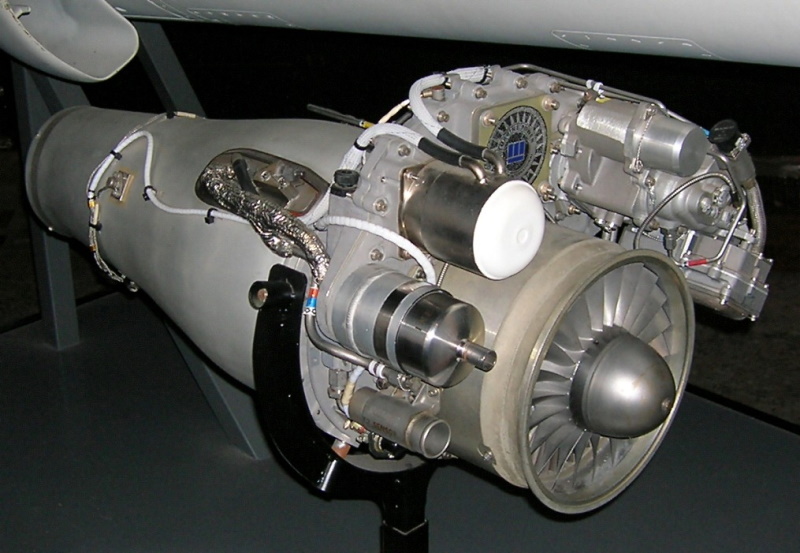
SCAD could be configured either as an unarmed decoy or attack weapon, the idea being to saturate and confuse Soviet defenses. SCAD certainly succeeded in causing confusion in the Air Force and the service's political overseers. Air Force brass feared that it would undermine support for their manned bomber fleet and did everything they could to emphasize "Decoy", instead of "Armed".
The SCAD had to be compatible with the existing rotary SRAM launcher carried in the bomb bay of the B-52. This restricted the weapon's length, and so its range. It also dictated that it have a trapezoidal cross-section, to allow the missiles to be nested together, as well as a "duck-bill" nose to allow it to clear the launcher. Of course, it had to have folding wings.
Weak commitment and rising program costs finally killed off SCAD in the summer of 1973. The program was almost immediately revived as the "Air-Launched Cruise Missile (ALCM)", which was purely an attack missile, not a decoy. The reason for this abrupt about-face was that the project had become attractive as a bargaining chip in the Strategic Arms Limitation Talks II (SALT II). The Air Force might have wanted a decoy, but ended up deciding that a weapon would be preferable, since it could be used to get political leverage against the Soviets.
In the meantime, the Navy had been working with General Dynamics on a cruise-missile concept of its own, called the "Submarine-Launched Cruise Missile (SLCM)" that could be launched out of a torpedo tube. This would eventually become the "Tomahawk" cruise missile, and is discussed below. The ALCM and SLCM had much in common, and so the Pentagon decided to leverage technologies between the two. Both missiles would end up having a terrain-following guidance system and a Williams Research F107 turbofan engine, with 2.65 kN (270 kgp / 600 lbf) thrust, though each type of missile would have different versions of the guidance system and engine.
Boeing produced the first version of the ALCM, the "AGM-86A", where AGM stood for "Air to Ground Missile", with first test flight in 1976. There were many failures, but eventually the bugs were worked out. However, in 1977, the government announced that there would be a competitive fly-off between the Boeing AGM-86 design and another ALCM based on the SLCM, the "AGM-109", in 1979.

That led to rethinking the AGM-86 project. The USAF had given ALCM low priority, and in fact there were many Air Force brass who had a low opinion of the whole idea of cruise missiles. The problem was that Congress was more enthusiastic, and the competition put Air Force leadership in the position of either developing an ALCM themselves or accepting whatever the Navy developed. The Air Force of course backed the Boeing design.
One of the most significant drawbacks of the original AGM-86A was its relatively short range, limited by the requirement that the missile fit into the existing B-52 SRAM launcher. The decision was made to abandon SRAM capability, and so Boeing came up with a new version of the ALCM, the "AGM-86B", that was 30% longer, giving it greater fuel capacity and longer range. The new missile could be carried on the underwing pylons of a B-52, but not on the bomb bay rotary SRAM launcher.
The fly-off between the Boeing AGM-86B and the GD AGM-109 duly took place in 1979. Both weapons performed poorly in tests: out of ten flights apiece, four of each crashed, and there were a number of other problems and failures. In 1980 the USAF went ahead selected the AGM-86B anyway, and the first production missiles were shipped to B-52 squadrons in 1981.

* The ALCM was powered by a Williams Research F107-100 engine, and carried a W-80 nuclear warhead with 200 kilotons yield, as developed for SRAM. ALCM was guided by an INS and a "Terrain Contour Matching (TERCOM)" navigation system. TERCOM used a downward-pointing radar altimeter to determine the missile's altitude as it flew toward a target, and compared the ground elevation profiles with maps stored in memory to determine if the missile was on course. The fact that the radar altimeter points straight down ensured that the missile didn't give itself away by its radar emissions, but since the missile flew at low altitude, mission planners had to ensure that it climbed when a TERCOM map predicted a cliff ahead.
___________________________________________________________________
BOEING AGM-86B ALCM:
___________________________________________________________________
wingspan:
3.7 meters (12 feet)
length:
6.3 meters (20 feet 8 inches)
total weight:
1,450 kilograms (3,200 pounds)
speed:
subsonic
range:
2,500 kilometers (1,550 MI / 1,350 NMI)
___________________________________________________________________
A total of 1,715 AGM-86Bs was built, with final deliveries in 1986. They were carried on the underwing pylons of B-52s, with each pylon carrying two tandem clusters of three missiles, for a total of 12 missiles. In 1986, Boeing also began modifying B-52s to carry eight ALCMs in a specially-designed rotary launcher in the bomb bay, for a total load of 20 ALCMs.
* The arms limitations treaties signed by the United States and the Soviet Union in the late 1980s singled out ALCMs for elimination as nuclear weapons, but allowed for their conversion to conventionally-armed missiles. The US Air Force had begun development work on a "Conventional ALCM (CALCM)" variant back in 1986, after US air attacks on Libya in 1985 codenamed Operation EL DORADO CANYON. Flight tests of the "AGM-86C" CALCM began in 1987.
The program was kept secret, since CALCMs seemed likely to be a useful weapon in the limited combat operations in which the US military was increasingly involved, and there was no reason to let potential enemies know what tricks the USAF might have in store for them. CALCMs were referred to as "Extra Long Range Bombs (XLRB)" in documents to help keep the secret. The program was codenamed SENIOR SURPRISE, though flight crews called the CALCMs "Secret Squirrels", after a super-spy cartoon character.
A small number of "Block 0" CALCMs were initially produced. While it appears that they were conversions from ALCMs, some sources also mention new production CALCMs. Due to the secrecy surrounding the program, estimates of CALCM inventories and production are uncertain.
The CALCMs had reduced fuel tankage to help accommodate a large 900-kilogram (2,000-pound) blast-fragmentation warhead, and were also fitted with a "Global Positioning System (GPS)" navigation satellite receiver system, with an inertial navigation system backup. The warhead sprayed a cloud of ball bearings and was optimized for dispersed, relatively unprotected targets such as surface-to-air missile (SAM) batteries.
CALCM was still secret during the Gulf War in 1991, while the Navy got all the publicity for introducing their Tomahawk cruise missile to combat. CALCM was actually used in the Gulf War, but that was not publicly revealed until 1992, when the Air Force reported that seven B-52Gs had fired 35 CALCMs at eight targets in northern Iraq. This action expended almost all the Air Force's inventory of CALCMs, but the service quickly arranged for further production.
Later production AGM-86Cs were in a "Block I" configuration, with a larger blast-fragmentation warhead weighing 1,360 kilograms (3,000 pounds). The Block I CALCMs also had an improved GPS-INS guidance system that cut their "circular error probability (CEP)" in half, meaning they were twice as accurate. It seems likely that the larger warhead was obtained by further reducing fuel capacity, but the Block I CALCM still has a range of 1,200 kilometers (745 miles).
Even with the larger Block I warhead, CALCM was unsatisfactory for attacks on hard targets, and so in 1998 the USAF began evaluating two different hard-target penetrating warheads, the Lockheed Martin "Advanced Unitary Penetrator (AUP)" and the British Aerospace "Multiple Warhead System (MWS)". Tests firings were performed on both warheads. An AUP fired in July 1999 punched through 3 meters (10 feet) of dirt, 1.5 meters (5 feet) of reinforced concrete, and then continued downrange for over 1,200 meters (4,000 feet). The AUP used kinetic energy and a hard case to penetrate, and had a "Hard Target Smart Fuze" to allow it to detonate at a preselected point within the target. The MWS used a two-stage warhead, based on a British Aerospace design known as "Broach". The first stage of the warhead blasted away soil, clearing the way for a kinetic energy penetrator.
The USAF incorporated an unspecified hard target warhead in 50 of the last batch of CALCM conversions, performed by Boeing in 1999 and 2000 after operations in the Balkans. CALCMs fitted with the hard target warhead were designated "Block IA" or "AGM-86D". The AGM-86 was finally retired in late 2019.
BACK_TO_TOP* Even as the ALCM was being introduced to service, the Air Force was working on a next-generation cruise missile. General Dynamics began work on what would be the "AGM-129 Advanced Cruise Missile (ACM)" in 1983, with first deliveries in 1987. Both an "AGM-129A" and a specialized "AGM-129B" variant were produced.
Production contracts were awarded to both General Dynamics and McDonnell Douglas through a second-source arrangement. Although 1,461 missiles were planned, only 450 were built due to rising costs and funding restrictions. Twelve ACMs could be carried on a B-52H's external pylons.
The ACM was intended to provide longer range, more sophisticated guidance, and greater stealth than ALCM for the nuclear strike role. The ACM was a sleeker weapon than the ALCM, and more exotic in appearance. Its pop-out wings were forward-swept, apparently as a stealth measure, making it one of the few flying machines with forward-swept wings to achieve full operational status. The tailplane was also forward swept, while the ventral tailfin was backward swept.
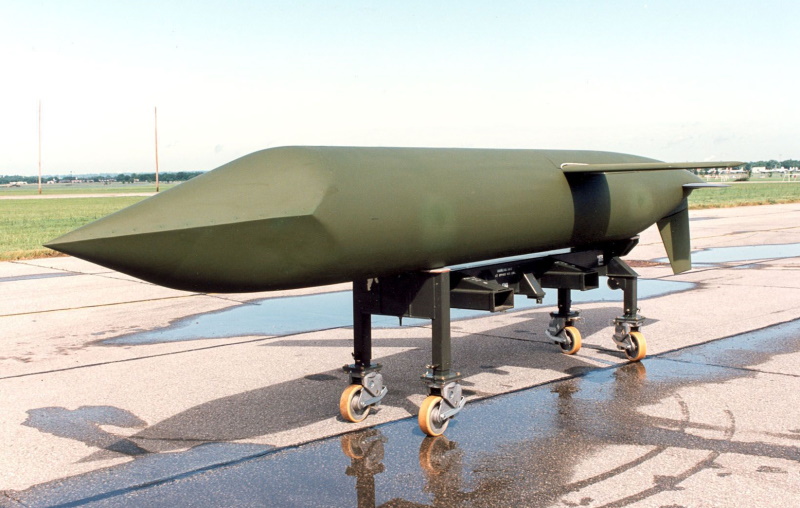
The ACM's fuselage was a streamlined spindle. The air intake was set flush into the missile's belly beneath the wing, and the exhaust was nocked into the end of the spindle just behind the tailfin. It was powered by a Williams Research F112-WR-110 turbofan engine with 4.0 kN (408 kgp / 900 lbf) thrust.
___________________________________________________________________
GENERAL DYNAMICS AGM-129 ACM:
___________________________________________________________________
wingspan:
3.13 meters (10 feet 3 inches)
length:
6.35 meters (20 feet 10 inches)
total weight:
1,250 kilograms (2,750 pounds)
speed:
subsonic
range:
3,330 kilometers (2,070 MI / 1,800 NMI)
___________________________________________________________________
The AGM-129A was armed with the same 200-kiloton W-80 warhead as the ALCM. Reports hinted that the AGM-129B had a specialized nuclear warhead, a penetrating munition for attacking "hard" targets such as underground command centers. There was some thought of performing a service-life extension program to keep the AGM-129 in service, but in 2010 the decision was made, in accordance with arms-control agreements with the Russians, to phase the ACM out. They were retired by 2013.
As a footnote to the ACM effort, Lockheed developed and test-flew their own missile design, codenamed SENIOR PROM, for the program. Little or no information was available on SENIOR PROM until 2005, when a set of photos and some data were released. The SENIOR PROM demonstrators had "faceted" airframes, giving them a certain general resemblance to the Lockheed F-117 Stealth Fighter, and were launched from Lockheed DC-130 Hercules drone controller aircraft. There were 13 test flights in 1979 or 1980 through 1981. The SENIOR PROM was also considered for the reconnaissance role, and there may have been some further development of the concept after General Dynamics won the ACM competition.
BACK_TO_TOP* The US Navy initiated development of what would become the Tomahawk SLCM in 1972, after deciding that the service needed a robot weapon that could fly under enemy radar and perform a precision strike on heavily-defended fixed "hard targets". Since the Navy did not have a long-range strategic bomber force, the new cruise missile did not really compete with existing Navy assets, and the Navy was much more enthusiastic about SLCM than the Air Force was for ALCM.
The Navy wanted to be able to fire the missile out of a torpedo tube, which restricted its length to 6.25 meters (20 feet 6 inches), its diameter to 53 centimeters (21 inches), and its weight to 1,910 kilograms (4,200 pounds). The weight limitation was imposed by the lifting capability of torpedo handling equipment. The weapon was named "Tomahawk".
Both nuclear and conventionally-armed versions were specified. By late 1973, the Navy had narrowed down the competition to two contenders, the General Dynamics "BGM-109" and the Ling-Temco-Vought (LTV) "BGM-110", where BGM stood for "Boosted Guided Missile". The Navy conducted a fly-off between the two missiles in 1976, and the General Dynamics BGM-109 was the winner.
The GD BGM-109 was externally similar to the LTV BGM-110 -- which was no great surprise, since both were designed to be launched from torpedo tubes, and naturally looked like torpedoes. Their detail design was very different, however. The BGM-109 used pop-out wings; flat tail surfaces that folded out; and a Williams Research engine. The BGM-110 used a one-piece wing that pivoted out from the fuselage; curved tail surfaces that unfolded from a ring around the tail of the missile; and a Teledyne engine. The BGM-109 was judged a bit more conservative and a safer bet.
The first launch of a Tomahawk from a surface ship took place in 1980. Since the Navy had decided to use cruise missiles from surface ships as well as submarines, the acronym SLCM was redefined to mean "Ship Launched Cruise Missile". The Tomahawk became operational in the early 1980s, and equipped US Navy attack submarines; SPRUANCE class destroyers and TICONDEROGA class cruisers; and, while they were still operational, the four IOWA class battleships that were nostalgically refurbished for combat during the Reagan Administration.
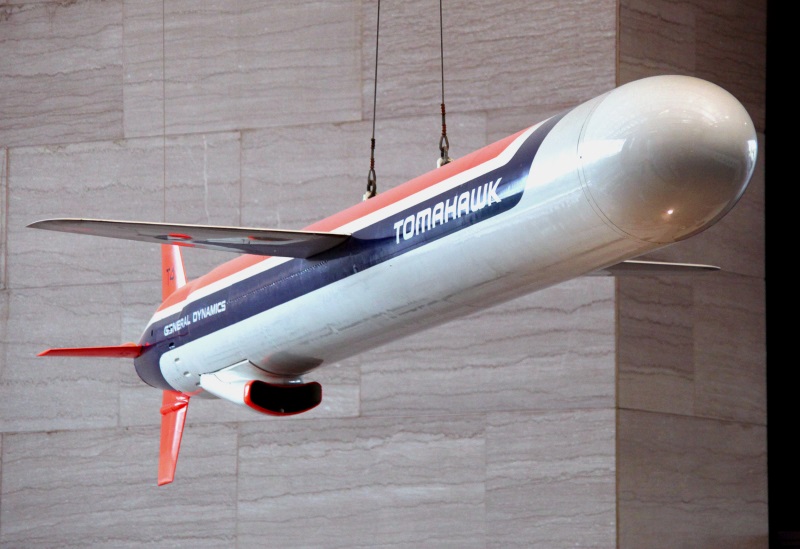
The Navy fielded four types of Tomahawks:
Each of these four types was built in two subvariants, one for surface launch and the other for submarine launch. For example, the surface launched subvariant of the BGM-109A was the "BGM-109A-1" (later "RGM-109A"), while the submarine launched subvariant was "BGM-109A-2" (later "UGM-109A", where "U" stood for "Underwater".) Tomahawks were built in a series of blocks -- basically three blocks, "Block I" through "Block III", with a number of sub-blocks. Details are discussed below.
Along with the Navy Tomahawks, as mentioned, General Dynamics developed a similar air-launched AGM-109 that lost the Air Force fly-off with the AGM-86B. General Dynamics also built a nuclear-tipped "Ground Launched Cruise Missile (GLCM / Glickem)" variant for the USAF, known as the "BGM-109G Gryphon", which was very similar to the Navy nuclear BGM-109A variant. It differed from the Navy variant mainly in the use of a different W-84 warhead and enhanced self-test capabilities.
The Gryphon was launched from a large wheeled tractor-trailer rig known as a "Transporter Erector Launcher (TEL)". The big tractor unit was built by MAN Diesel of Germany, and it pulled a trailer that carried and fired four missiles from a large box that pivoted up from the rear of the trailer bed. The project was initiated in 1977; first flight tests of the GLCM were in 1980, with first launch from a TEL in 1981.
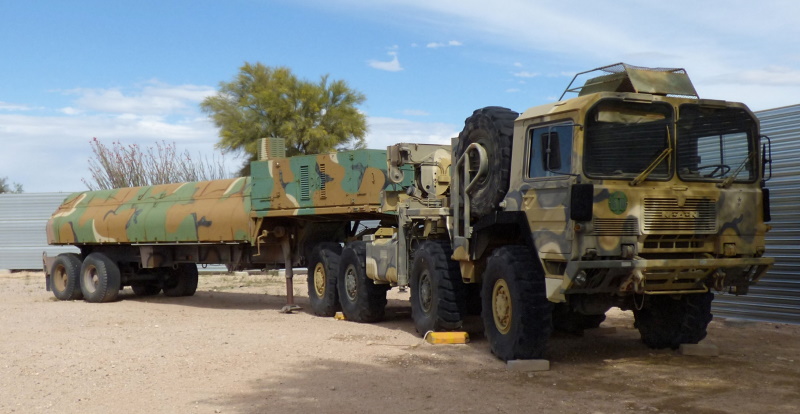
The GLCM was built in response to the Soviet SS-20 missile, a mobile weapon with three warheads that the USSR had deployed in numbers in Eastern Europe during the late 1970s. 464 production GLCMs were built; they were deployed to Europe beginning in 1983 to sites in Belgium, Sicily, the UK, and West Germany. In a time of crisis, the TELs were to be driven to predesignated sites and camouflaged; they were accompanied by a convoy of support vehicles, including trucks carrying security teams, with the convoy amounting to about 20 vehicles. If push came to shove, navigation and targeting information would be downloaded into the missiles, and two officers would jointly perform the authentication procedure for launch. The missiles would fly at high altitude over "friendly" territory and then descend to low altitude for penetration into Warsaw Pact airspace.
There were loud public protests in many countries over the GLCMs, most particularly at Greenham Common in the UK, where a group of protesters set up a camp and engaged in a wide range of amusing theatrics. The vehicles had to be "protester proofed", with screens installed in the gas caps to prevent foreign objects from being dumped into the fuel tanks, and parts of the vehicles had to be protected as best as possible from paint bombs and other annoyances. The protests never got out of control, nobody ever got seriously hurt, and in the end it all ended well.
After several years of tough negotiations, in 1987 the US and the Soviet Union signed the "Intermediate-Range Nuclear Forces (INF)" treaty, which required both sides to withdraw forward-based nuclear armed missiles from Europe and destroy them. The GLCMs were pulled out of Europe beginning in 1988, and were subsequently destroyed, while the Soviets pulled their SS-20s out and destroyed them as well. The treaty allowed salvage of their engines and guidance systems for conventionally armed Tomahawks; eight GLCMs were also disarmed and reserved for use as museum displays, as permitted under the treaty. As discussed later, however, GLCM would not stay dead.
While the air-launched AGM-109 Tomahawk never entered production, Hughes did promote an air-launched derivative known as the "AirHawk" for the British "Conventionally Armed Stand Off Missile (CASOM)" competition in 1995. Exactly what relationship Hughes had with General Dynamics at the time is difficult to determine, given the extremely confusing reshufflings of US defense contractors in the 1990s.
The AirHawk was about 43 centimeters (17 inches) shorter than the Tomahawk, had a third of the range due to smaller fuel capacity, and a new warhead. Hughes offered an even shorter version of the AirHawk for the US "Joint Air to Surface Standoff Missile (JASSM)" program, discussed later, but there were no takers, and the AirHawk never went beyond the mockup stage.
* All Tomahawk variants had the same basic configuration, but they varied in guidance system and warhead. Wings popped out from the body; due to stowage constraints, one wing was mounted higher on the fuselage than the other. There were four control fins that fold out from the tail of the fuselage. There were no control surfaces on the wings.
___________________________________________________________________
GENERAL DYNAMICS TOMAHAWK TLAM-C:
___________________________________________________________________
wingspan:
2.67 meters (8 feet 9 inches)
length no booster:
5.54 meters (18 feet 3 inches)
length with booster:
6.25 meters (20 feet 6 inches)
total weight:
1,500 kilograms (3,300 pounds)
warhead weight:
450 kilograms (1,000 pounds)
speed:
885 KPH (550 MPH / 480 KT)
range:
1,120 kilometers (700 MI / 610 NMI)
___________________________________________________________________
Weight varied slightly between Tomahawk versions. For example, submarine launched variants weighed about 36 kilograms (80 pounds) more than surface launched variants, due to the addition of waterproofing hardware and a pressure venting system. The missile was stored on board ship in a 400-kilogram (900-pound) sealed stainless steel handling capsule for submarine use, and a lighter aluminum capsule for surface ships.
All variants were powered by the Williams Research F107-WR-400 with 2.94 kN (300 kgp / 660 lbf) thrust. High-energy TH-dimer fuel was used instead of JP-5, which bought the missile about an extra 200 kilometers (125 miles) of range. The fuel was divided among several tanks to ensure flight trim.
When launched from a submarine, the missile was loaded into a torpedo tube inside its capsule. The Tomahawk was then ejected from the capsule and the torpedo tube by water injected through the rear of the capsule, which forced the missile through a diaphragm in front. A lanyard-tripped switch told the missile when it had separated from the capsule. A moment later, the guidance system determined if the missile had the right attitude and velocity, then fired the solid-rocket booster. For launch from a surface vessel, the missile was blasted from an "Armored Box Launcher" or vertical launch silo on its booster. Once the Tomahawk was into the air, it jettisoned covers from the turbofan engine inlet and the folded wing slots, as well as a fairing between missile and booster.
For the first few instants of flight, the missile was controlled by four vanes in the booster rocket exhaust. The booster burned for a total of about 12 seconds. Then the four tail-control fins took over, rolling the missile into a wings-level attitude. The wings popped open while the booster was still burning, generating lift so the missile could move out on a flatter trajectory to avoid detection. When the booster burned out and fell away, the turbofan inlet popped open and cruise began at an altitude of 60 meters (200 feet). The low altitude and small size of the missile made it difficult to detect on radar, and its small engine was quiet and had a low infrared signature. Radar absorbing materials were used in projecting parts like the air inlet.
The navigation system, as mentioned, depended on the variant. The TLAM-N strategic nuclear variant provides a baseline. Initial navigation was by an INS, which guided the weapon to land. Once the missile was over land, a TERCOM terrain following system, functionally identical to that used in ALCM, was used to guide the missile to the target.
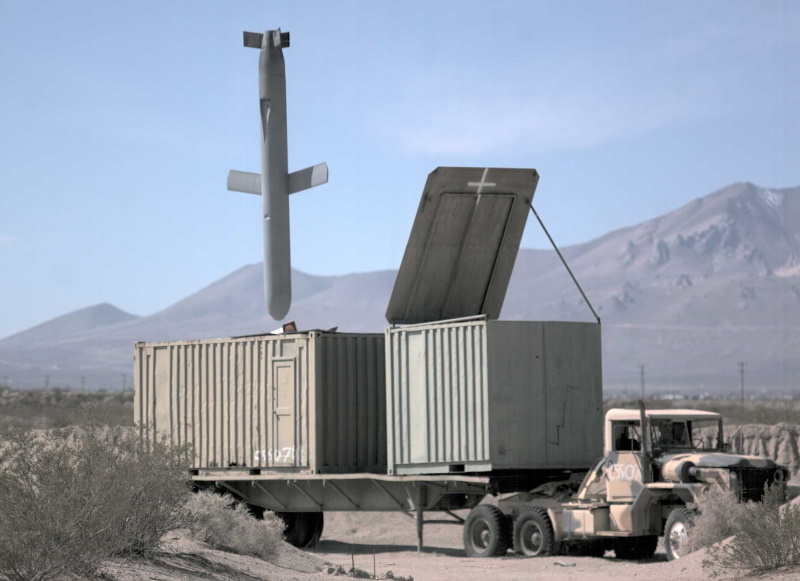
TERCOM provided sufficient accuracy for a nuclear strike, but the conventionally armed TLAM-C and TLAM-D missiles required greater accuracy to be effective. They retained the INS and TERCOM system used on the TLAM-N, but had an additional "terminal guidance" system for precision targeting, known as "Digital Scene Matching Area Correlator (DSMAC)". DSMAC featured an electronic camera in the nose of the missile that provided an image to a digital processor, which matched it to pre-programmed target features. Although some care had to be taken to program the processor to recognize unique and unchanging features, accuracy could be extremely high. A strobe flash was also provided along with the camera to help with targeting on night flights.
The conventional warhead TLAM-C had three terminal attack modes:
The ship attack TASM variant had an INS, but no TERCOM, since it was meant to attack mobile targets at sea whose exact position was not necessarily known. The INS took the missile to the target area, where it then flew a winding search pattern, looking for a target. It recognized the target with two different "seekers", one that performed active radar homing and the other that passively sensed radar emissions from the target. The targeting system did not have any "identification friend or foe (IFF)" capability, and so no friendly vessels could be in the target area. Once the TASM identified a target, it then attacked it. It could either strike the target broadside, or execute a last minute "pop up" and dive down into the deck.
The TLAM-N strategic nuclear variant was armed with the same W-80 warhead used on ALCM. The TLAM-N was the lightest of the Tomahawks, and had the longest range, of up to 2,400 kilometers (1,500 miles).
Both the conventional TLAM-C and the ship-attack TASM used the same conventional unitary warhead, the 450-kilogram (1,000-pound) WDU-25B semi-armor piercing warhead, developed for the USAF's Bullpup-B missile in the 1950s. The warheads appear to have been salvaged from scrapped Bullpup-Bs. Due to the bigger warhead, the TLAM-C was the heaviest of the Tomahawks and its range was cut to 1,120 kilometers (700 miles). However, the TASM had the shortest range, 480 kilometers (300 miles), since it had to spend much of its time shuttling around in the target area in a search pattern.
The TLAM-D, with its cluster munition warhead, was most similar to the TLAM-C and had similar range. Instead of the unitary warhead of the TLAM-C, however, it was armed with a dispenser system carrying 166 "BLU-97/B Combined Effects Munitions (CEMs)", fired out the sides of the nose after panels were blown off. Each CEM was about the size of a soft-drink can, and weighed about a kilogram and a half (3.4 pounds). It was stabilized by a cloth strip on the tail, had a hollow-charge anti-armor explosive core that blasted forward, a fragmenting body, and a zirconium incendiary ring. The TLAM-D could dispense the CEMs in batches, allowing the missile to hit multiple targets, and then fly on to act as a decoy or crash into a soft target and destroy it by impact.
As mentioned, Tomahawks were initially produced in three major blocks:
The antiship TASM was withdrawn from service in the 1990s; the nuclear TLAM-N had been withdrawn from service by 2013. Neither had ever been used in anger, which was just as well for the TLAM-N.
The Tomahawk was acquired by foreign forces. In 1999, the British Royal Navy closed a deal to obtain 65 Block III Tomahawk SLCMs. The British were the first nation to acquire the Tomahawk from the United States. The Royal Navy acquired a second batch of 20 Block III Tomahawks in 2001, with a third batch of 22 acquired in 2003, for a total buy of 107 Block III missiles. Five Royal Navy submarines were fitted to carry and launch the Tomahawks.
BACK_TO_TOP* Although American cruise missiles of the 1950s saw no use, in more recent times they have become an important part of US military capability, seeing considerable combat use, as discussed below. The increasing expenditure of cruise missiles from the early 1990s raised concerns about maintaining inventory, and also of reducing costs. In the late 1990s, the USN decided to obtain the cost-reduced "RGM-109E Block IV" Tomahawks, better known as the "Tactical Tomahawk (TACTOM)", from Raytheon, which inherited the Tomahawk business from General Dynamics.
TACTOM cost about half as much as a Block III Tomahawk. The major cost reduction was due to elimination of the requirement for launching the missile from a torpedo tube. Torpedo tube launch imposes unusual stresses on the missile, and the missile had to be ruggedized to survive incidental battle damage, since it was stowed near crew bunks. Attack submarines with vertical launch tubes could still fire Tactical Tomahawks.
Eliminating the need for torpedo tube launch reduced the empty weight and permitted greater fuel capacity. Instead of using the additional fuel capacity to obtain greater range, Raytheon decided to replace the Williams Research F107-402 turbofan with a less efficient but much cheaper small turbojet. The original engine candidate was the Teledyne J402, used on the Harpoon antiship missile -- but though it was much cheaper than the F107, it couldn't meet range requirements. Raytheon settled for the new Williams Research F415-WR-400 turbojet. The engine change slipped the program by two years.
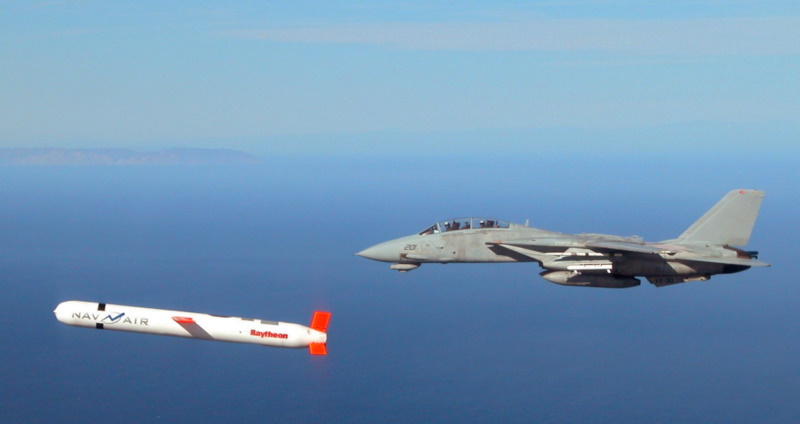
The Tactical Tomahawk also featured a greatly reduced parts count to lower cost and improve reliability. The total number of parts was reduced by at least a quarter, with the number of connectors reduced by almost three quarters, and the number of circuit boards cut by more than half. The number of tailfins was even cut from four to three, giving the TACTOM a distinctive external recognition feature.
While the Tactical Tomahawk was cheaper, it also had a number of enhancements:
The new features of the missile were reflected in a new "Tactical Tomahawk Weapons Control System (TTWCS)", which not only supported the inflight reprogramming of the missiles, but also ripple-firing of up to six TACTOMs at once. The initial test flight of the TACTOM was on 23 August 2002, with initial delivery of a production weapon in the spring of 2004 and service introduction before the end of 2004. Over 3,000 TACTOMs have been delivered to date.
The service then went on to acquire a TACTOM with the WDU-43/B penetrator warhead. This variant, the "TACTOM Penetrator Variant (TTPV)" or "RGM-104H", went into service in 2005. Other possible warloads included:
The Navy worked on further enhancements for the Tomahawk, such as a substantially more powerful "Multiple Effects Warhead (MEW)" -- later "Joint MEW (JMEW)" -- along with a "Precision Target Aided Navigation (PTAN)" capability to provide pinpoint strike even in the presence of GPS jamming. There was also work on a seeker system, derived from the AGM-88 anti-radar missile, to allow the TACTOM to home in on radar and other radio emitters; on a millimeter-wave radar or electro-optic seeker system to hit mobile targets; and on networking to allow a Tomahawk to get targeting cues from a surveillance platform, allowing it to hit moving targets even without a new seeker.
In 2004 the British Royal Navy, following up their buy of 107 Block III Tomahawks, placed an order for up to 105 TACTOMs. The British requested changes that would permit torpedo-tube launch of the TACTOMs. The Netherlands and Spain were interested in buying TACTOMs, but backed out.
BACK_TO_TOP* Along with the Tomahawk Anti-Ship Missile, the US Navy obtained a purpose-built antiship cruise missile, the "Harpoon". It began life with studies performed in the late 1960s for an air-launched antiship missile. These studies congealed in 1971 in a requirement for a weapon that could also be launched by submarine or surface vessel. McDonnell Douglas was awarded a preliminary development contract in 1971, leading to a prototype flight test in December 1972, followed by a full development contract in 1973. Extensive prototype flight tests in 1974 and 1975 led to initial production in 1976.
The first operational "Block I" version of the Harpoon was designated "AGM-84A" for the air-launched version, "RGM-84A" for the ship-launched version, and "UGM-84A" for the submarine-launched version. The RGM prefix is used as the default in the following discussion. The RGM-84A had a range of 120 kilometers (75 miles), and featured a terminal attack mode with a pop-up to approximately 1,800 meters (5,900 feet) before diving on the target, hitting the relatively soft topdeck.
The British Royal Navy obtained the Block I as the "RGM-84B", featuring minor tweaks. The "Block IB" AKA "RGM-84C" deleted the terminal pop-up, presumably because it made the missile easier to shoot down, while the "Block IC" AKA "RGM-84D" made the pop-up attack optional, and featured a high-energy fuel that extended the range to 220 kilometers (135 miles). It also featured improved electronic counter-countermeasures (ECCM) and a waypoint navigation system.
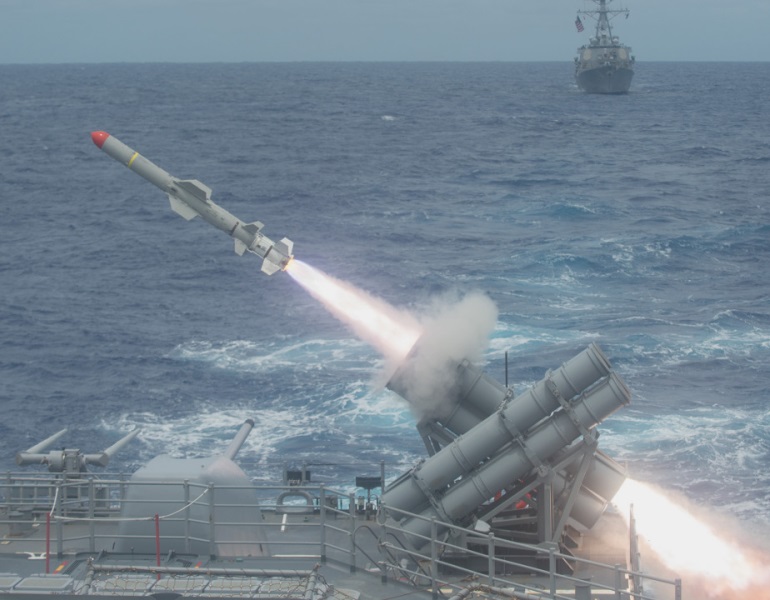
* The Block IC Harpoon, as introduced, was a torpedo-like missile, with four short wings mounted in the midbody and four shorter tailfins for control. The missile was fitted with a semi-armor-piercing (SAP) warhead, and powered by a Teledyne CAE J402 turbojet engine, with 2.94 kN (300 kgp / 660 lbf) thrust.
___________________________________________________________________
RGM-84 HARPOON (SHIP LAUNCHED):
___________________________________________________________________
wingspan:
0.90 meters (3 feet)
length:
3.84 meters (12 feet 7 inches)
diameter:
34 centimeters (13.5 inches)
total weight:
550 kilograms (1,200 pounds)
warhead weight:
225 kilograms (500 pounds)
speed:
1,050 KPH (650 MPH / 565 KT)
range at altitude:
120 kilometers (75 MI / 65 NMI)
___________________________________________________________________
When fired from a ship, submarine, or ground battery, the Harpoon was sent into the air with a solid rocket booster that generated 53.9 kN (5,500 kgp / 12,000 lbf) thrust for just under three seconds. The booster added 75 centimeters (29 inches) to the missile's length and 160 kilograms (350 pounds) to its weight.
The Harpoon could be carried by cruisers, destroyers, frigates, patrol craft, and attack submarines -- it seems it wasn't carried by ballistic-missile submarines because that wasn't their mission. Ground-launch systems were developed for coastal defense, though only Denmark and Taiwan acquired the ground-launched Harpoon. For shipboard launch, the Harpoon was generally fired from a ship's existing Mark 121 2-tube or Mark 141 4-tube fixed launchers; it could also be fired from the Mark 16 9-cell turreted "Matchbox" launcher for the ASROC missile. Apparently, it could also be launched from some types of Tartar SAM rail launchers. At last notice, it couldn't be fired from VLS launchers.
The ground-launch system developed for Denmark had four launch tubes on a truck, clearly being an adaptation of the shipboard launch system. Each battery had two launch trucks, plus a radar vehicle and a command vehicle. When launched from a submarine, the Harpoon was shot out of a torpedo tube in its canister. When the canister left the torpedo tube, a lanyard caused the canister to pop out fins, to then glide upward towards the surface of the water. Once the canister breached the surface, it blew off its tail and cap, and fired the Harpoon on its solid-fuel booster.
No matter how the Harpoon was launched, it was directed to a preprogrammed target area by an INS, where it would conduct an autonomous search for a naval target. A number of different search patterns could be programmed into the missile; the patterns not only increased the probability of detecting the target, but made it harder to trace the missile's flight path back to its launcher. In any case, the Harpoon swept through the pattern while hunting for a target using its radar seeker. When the missile found a target, it dropped down to wave height and homed in on it. As noted, the AGM-84D could strike the target broadside, or perform a pop-up attack. While the guidance system was sophisticated, it was also indiscriminate, and the missile could not be launched into a target area where friendly forces were operating.
* The Harpoon's first combat use was in 1980, at the outset of the Iran-Iraq War. The Shah of Iran had obtained the Harpoon, deploying it with small missile boats, which the Islamic Republic of Iran inheriting them after the fall of the Shah's regime. On 28 November 1980, Iranian and Iraqi missile boats got into a confrontation, with exchanges of antiship missiles; the Iraqis apparently got the worst of it, with a number of missile boats sunk.
The US didn't use Harpoons in combat until 1986. On the night of 24 to 25 March 1986, US Sixth Fleet A-6E Intruders used them to sink three Libyan patrol vessels in the Mediterranean. One pilot commented: "I doubt the Libyans even saw it coming." It was also used against the Iranians during the Gulf convoy operations in 1988, sinking the Iranian frigate SAHAND and contributing to attacks on other Iranian vessels. The Harpoon was not used in the Gulf War out of fear of hitting friendly forces.
* Following the Block ID / RGM-84D, further improved Harpoons were developed:
Due to the purchase of McDonnell Douglas by Boeing, the Harpoon is now the Boeing Harpoon. Boeing worked on a "Block III" Harpoon, but it was canceled. The company ended up developing a "Block II+ / AGM-84Q" variant, with an improved GPS-INS guidance unit and a datalink. It is available as new production or update. Early Harpoons updated to AGM-84Q spec are known as "Block II+" weapons; later Harpoons, with extended range, are known as "Block II+ ER" weapons.
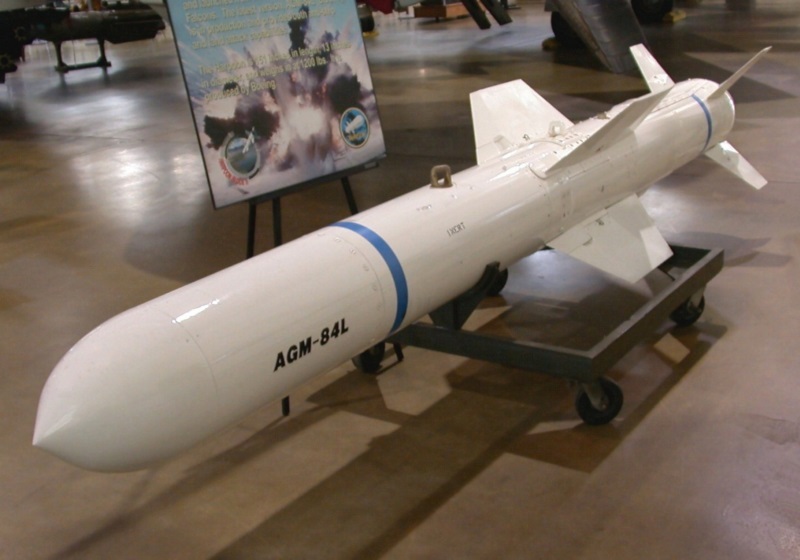
Well over 6,000 Harpoons have been built, and the weapon is in service with dozens of military forces. The Israelis are enthusiastic users, and in fact have implemented a "Harpoon Enhanced Performance" update program on their weapons, though details are classified. India is one of the most recent users, acquiring the weapon for their Boeing 737-based P-8I maritime patrol aircraft. Ukraine obtained early-model Harpoons and a shore-launch capability from Denmark, Britain, and Spain, using the Harpoon to sink at least one Russian warship.
* When the US Navy wanted to obtain a stand-off air-to-ground missile in the mid-1980s, they went to the Harpoon as a proven design to work from. The result was the "Stand-Off Land Attack Missile (SLAM)" -- the original variant being the Harpoon "Block 1E / AGM-84E".
The AGM-84E's airframe was the same as that of the Harpoon, except that it was "stretched" 70 centimeters (2 feet 4 inches), to a total length of 4.4 meters (14 feet 6 inches), along with an increase in weight of 70 kilograms (150 pounds). It retained the midcourse guidance system of the AGM-84D, but added the imaging infrared seeker of the AGM-65D Maverick and the data link of the AGM-62 Walleye glide bomb. It was strictly air-launched, with the launch aircraft carrying a datalink pod. It was originally carried on the Grumman A-6 Intruder and the McDonnell-Douglas F/A-18 Hornet. MDD tried to promote a booster-launched "Sea SLAM", but nobody bought it.
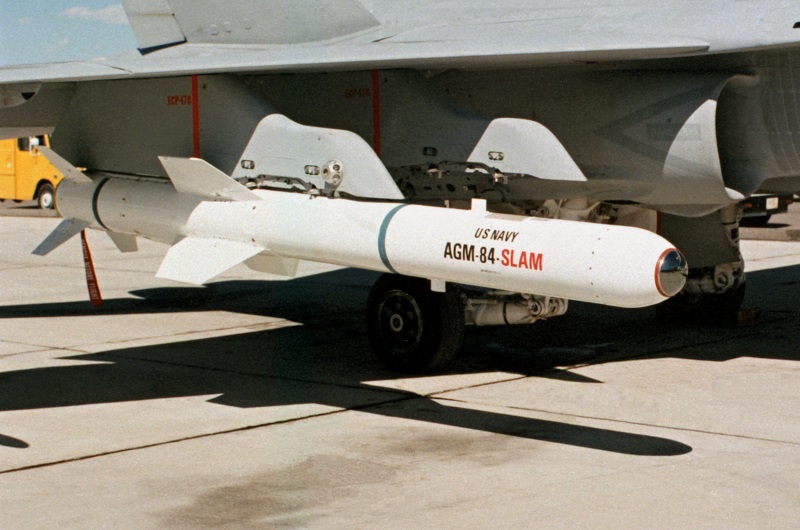
A handful of preproduction SLAMs were launched against Iraqi targets in the First Gulf War. The missile obtained full operational status in 1993. An automated mission planning system was introduced in 1996. After the Gulf War, the Navy decided that it needed a better standoff capability, and so decided to come up with an improved "SLAM-ER" (where "ER" stood for "Expanded Response"), awarding a contract for the new variant to MDD in 1995. SLAM-ER was given the designation "Block 1G / AGM-84H".
SLAM-ER's most visible difference to its predecessor was that the four stubby wings were replaced by a pair of long swept inverted gull wings, with a span of 2.2 meters (7 feet 2 inches). The wings were stowed pointed back under the fuselage before launch and pivoted forward after release. The warhead was the same size as before, but had a titanium casing to improve hard target penetration. Range was extended to over 280 kilometers (172 miles).
The SLAM-ER retained the GPS-INS guidance system and infrared-imaging targeting scheme used in SLAM. The targeting system was enhanced to allow the missile operator to "freeze" the image returned by the missile, set crosshairs on a particular aim point on the image, and then instruct the missile to seek that aimpoint. The first SLAM-ER flight took place in 1997. It was first used in combat in late 1999, when a Navy F/A-18 fired one at an Iraqi military facility in the southern "No-Fly" zone. All AGM-84E SLAMs were updated to SLAM-ER configuration.

Although SLAM-ER wasn't optimized as an antiship weapon, a ship's just another target for a precision-guided weapon, and in January 2000 the US Navy performed a live-fire test on a decommissioned cruiser, the USS DALE. Warhead effectiveness "exceeded expectations", according to Boeing. Unfortunately, other tests did not give as much credit to SLAM-ER, with one series of eleven test launches only scoring five hits, poor performance for a precision-guided weapon. Corrective actions were taken and performance in tests dramatically improved.
The "Block 1G / AGM-84K" variant was introduced in 2002, the main change being incorporation of an "automatic target acquisition (ATA)" capability, plus a re-attack capability -- the improved variant sometimes being labeled "SLAM-ER ATA" or "SLAM ATA". AGM-84H missiles were updated to AGM-84K standard, and the AGM-84K has since been given software updates. The SLAM remains in first-line US Navy service, the carrier aircraft being the F/A-18 Super Hornet. The SLAM hasn't been exported, though there's discussion about sales to Taiwan.
BACK_TO_TOP